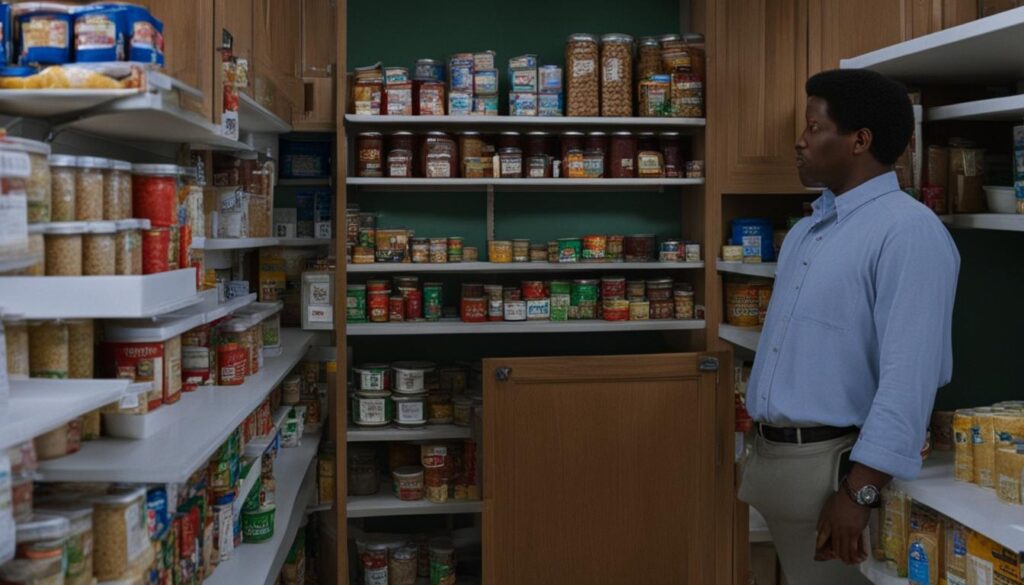Are you ready to take control of your finances and level up your money management skills? Look no further than social media’s best financial challenges! These challenges have taken the online world by storm, providing individuals with a fun and interactive way to improve their financial well-being. From savings challenges to spending limits, there’s something for everyone on their journey to financial freedom.
Embracing these challenges allows you to gamify the process of saving money and developing healthy financial habits. By participating, you’ll not only join a supportive community but also gain valuable insights and tips from others who are on the same journey as you. Whether you choose the 52-week savings challenge, the no-spend challenge, or any other money challenge, these opportunities can transform your financial future.
Key Takeaways:
- Social media offers a variety of financial challenges to improve money management skills.
- Participating in challenges can provide a sense of community and support.
- Challenges like the 52-week savings challenge and the no-spend challenge can help set spending limits and increase savings.
- Embracing financial challenges can lead to financial freedom and a healthier financial future.
- Join the challenge today and take a step towards achieving your financial goals!
The 52-Week Savings Challenge
The 52-week savings challenge is a popular financial challenge on social media that has gained traction among individuals looking for creative ways to save money. The premise of the challenge is simple: participants commit to saving a specific amount each week for a year. This challenge can be tailored to fit individual preferences, with some opting to increase the savings amount each week for a more ambitious goal. By the end of the challenge, participants can accumulate a significant sum of money, which can serve as a financial cushion or be put towards a specific financial goal.
One of the key benefits of the 52-week savings challenge is its flexibility. Participants can adjust the savings amount based on their personal financial situation, making it accessible to individuals with different income levels. Additionally, the challenge encourages individuals to develop money-saving strategies and find creative ways to reach their weekly savings goal. This might involve cutting back on discretionary expenses, finding cost-effective alternatives, or exploring additional sources of income.
The 52-week savings challenge provides individuals with a structured approach to saving money while fostering discipline and financial responsibility. It serves as a reminder of the importance of consistently setting aside a portion of income for future financial needs and goals.
Moreover, the 52-week savings challenge creates a sense of accountability and motivation. Participants often share their progress on social media platforms, creating a supportive community where ideas, tips, and strategies for saving money are exchanged. This communal aspect adds an element of fun and encouragement to the challenge, making the process of saving money more engaging and enjoyable.
| Savings Week | Savings Amount |
|---|---|
| Week 1 | $10 |
| Week 2 | $20 |
| Week 3 | $30 |
| Week 4 | $40 |
By embracing the 52-week savings challenge, individuals can develop a habit of saving and gain control over their financial future. Whether it’s for an emergency fund, a down payment on a home, or a dream vacation, this challenge provides a structured and motivating framework for individuals to achieve their financial goals.
The No Spend Challenge
The no-spend challenge is a popular financial challenge that encourages individuals to refrain from making unnecessary purchases for a set period of time. This challenge is all about cutting expenses, saving money, and becoming more mindful of our spending habits. By participating in the no spend challenge, individuals can develop a greater appreciation for the value of money and learn to prioritize essential needs over wants.
During the no spend challenge, participants focus on finding creative alternatives to spending money. Rather than going out for dinner, they may choose to cook a meal using ingredients they already have in their pantry. Instead of buying new clothes, they may explore their wardrobe and put together new outfits from existing items. This challenge encourages resourcefulness and helps individuals realize that they have more than they think.
One of the key benefits of the no spend challenge is the significant amount of money that can be saved. By avoiding unnecessary purchases, individuals can free up funds that can be used for more meaningful expenses or saved for future goals. This challenge also helps individuals identify their spending triggers and develop healthier habits around money. It’s an opportunity to break free from impulsive buying and make more intentional choices.
Benefits of the No Spend Challenge:
- Save money by cutting unnecessary expenses
- Become more mindful of spending habits
- Develop a greater appreciation for the value of money
- Identify spending triggers and break free from impulsive buying
- Learn to prioritize essential needs over wants

| Challenges | Duration | Key Focus |
|---|---|---|
| The 52-Week Savings Challenge | 1 year | Saving money and building a financial cushion |
| The No Spend Challenge | Various (e.g., week, month) | Reducing expenses and cutting unnecessary purchases |
| The Pantry Challenge | Customizable | Using existing pantry items to reduce food waste |
The Pantry Challenge
The pantry challenge is a popular financial challenge that promotes mindful spending and reducing food waste. Participants commit to using only the items already available in their pantry and refrigerator before making additional grocery purchases. This challenge encourages individuals to be resourceful in meal planning, make more intentional choices, and ultimately save money on their grocery bills.
By focusing on utilizing what is already on hand, participants can reduce food waste and prevent ingredients from going bad. This not only helps the environment but also saves money by avoiding unnecessary purchases. The pantry challenge also encourages individuals to get creative with their meal planning, finding new and delicious ways to use ingredients they already have.
This challenge promotes mindful spending as individuals become more conscious of their grocery needs and prioritize using what they already have. It can be an eye-opening experience as participants discover the variety of meals they can create without constantly buying new ingredients. Through mindful spending and reducing waste, individuals can develop healthier financial habits and make their food budget stretch further.
| Benefits of the Pantry Challenge: |
|---|
| Reduces food waste |
| Promotes mindful spending |
| Helps save money on grocery bills |
| Encourages resourcefulness in meal planning |
The pantry challenge is a great way to not only save money but also become more mindful of your spending habits and reduce food waste. By utilizing what is already in your pantry, you can create delicious meals while developing healthier financial habits. So why not take on the challenge and see how much you can save while enjoying creative and resourceful cooking?

Testimonials
“The pantry challenge has been a game-changer for my budget. I’ve discovered so many amazing recipes using ingredients I already had but never thought to combine. It’s not only saved me money but also made cooking more exciting and adventurous!” – Sarah
“I used to waste so much food without even realizing it. The pantry challenge has made me more mindful of what I have and how to use it effectively. I can’t believe how much money I’ve saved by simply shopping my own pantry!” – Mark
Conclusion
Participating in financial challenges through social media can have a profound impact on individuals’ financial goals. These challenges not only provide a sense of community and support but also offer valuable insights and tips from fellow participants who are also striving for financial well-being. By joining these challenges, individuals become part of a thriving financial community, encouraging and motivating one another to achieve financial freedom.
The benefits of embracing financial challenges extend beyond the community aspect. The gamification element makes the process of saving money more enjoyable and engaging, turning what could be a daunting task into a fun and rewarding experience. Whether it’s the 52-week savings challenge, the no-spend challenge, or any other money challenge, these initiatives provide individuals with the opportunity to develop healthy financial habits and gain control over their financial future.
Financial challenges on social media empower individuals to set spending limits, increase their savings, and make intentional financial decisions. By participating in these challenges, individuals not only improve their money management skills but also cultivate mindfulness around spending and develop a greater appreciation for the value of money. These challenges act as stepping stones towards a more secure financial future and help individuals achieve their long-term financial goals.
FAQ
What are some popular financial challenges on social media?
Some popular financial challenges on social media include the 52-week savings challenge, the no-spend challenge, and the pantry challenge.
How does the 52-week savings challenge work?
The 52-week savings challenge involves committing to save a specific amount each week for a year, with some variations allowing for an increase in the savings amount over time.
What is the purpose of the no-spend challenge?
The no-spend challenge encourages individuals to refrain from making unnecessary purchases for a set period of time, promoting mindful spending and reducing expenses.
What is the pantry challenge?
The pantry challenge requires participants to use only the items already available in their pantry and refrigerator before purchasing additional groceries, helping reduce food waste and save money on grocery bills.
What are the benefits of participating in social media financial challenges?
Participating in these challenges offers a sense of community and support, valuable insights and tips from others, and a more enjoyable and engaging way to save money.
How Can Social Media Help in Setting and Achieving Financial Goals?
Social media is more than just a platform to share personal updates and connect with friends. It can be an effective tool for setting financial goals and seeing them through. By joining communities or following experts, individuals can gain insights, tips, and resources to achieve their monetary targets. Additionally, using social media to track progress and hold oneself accountable can provide the necessary motivation to stay on track. Setting financial goals with social media ensures individuals have the necessary support and knowledge to attain financial success.
By embracing the 52-week savings challenge, individuals can develop a habit of saving and gain control over their financial future. Whether it’s for an emergency fund, a down payment on a home, or a dream vacation, this challenge provides a structured and motivating framework for individuals to achieve their financial goals.
The No Spend Challenge
The no-spend challenge is a popular financial challenge that encourages individuals to refrain from making unnecessary purchases for a set period of time. This challenge is all about cutting expenses, saving money, and becoming more mindful of our spending habits. By participating in the no spend challenge, individuals can develop a greater appreciation for the value of money and learn to prioritize essential needs over wants.
During the no spend challenge, participants focus on finding creative alternatives to spending money. Rather than going out for dinner, they may choose to cook a meal using ingredients they already have in their pantry. Instead of buying new clothes, they may explore their wardrobe and put together new outfits from existing items. This challenge encourages resourcefulness and helps individuals realize that they have more than they think.
One of the key benefits of the no spend challenge is the significant amount of money that can be saved. By avoiding unnecessary purchases, individuals can free up funds that can be used for more meaningful expenses or saved for future goals. This challenge also helps individuals identify their spending triggers and develop healthier habits around money. It’s an opportunity to break free from impulsive buying and make more intentional choices.
Benefits of the No Spend Challenge:
- Save money by cutting unnecessary expenses
- Become more mindful of spending habits
- Develop a greater appreciation for the value of money
- Identify spending triggers and break free from impulsive buying
- Learn to prioritize essential needs over wants

| Challenges | Duration | Key Focus |
|---|---|---|
| The 52-Week Savings Challenge | 1 year | Saving money and building a financial cushion |
| The No Spend Challenge | Various (e.g., week, month) | Reducing expenses and cutting unnecessary purchases |
| The Pantry Challenge | Customizable | Using existing pantry items to reduce food waste |
The Pantry Challenge
The pantry challenge is a popular financial challenge that promotes mindful spending and reducing food waste. Participants commit to using only the items already available in their pantry and refrigerator before making additional grocery purchases. This challenge encourages individuals to be resourceful in meal planning, make more intentional choices, and ultimately save money on their grocery bills.
By focusing on utilizing what is already on hand, participants can reduce food waste and prevent ingredients from going bad. This not only helps the environment but also saves money by avoiding unnecessary purchases. The pantry challenge also encourages individuals to get creative with their meal planning, finding new and delicious ways to use ingredients they already have.
This challenge promotes mindful spending as individuals become more conscious of their grocery needs and prioritize using what they already have. It can be an eye-opening experience as participants discover the variety of meals they can create without constantly buying new ingredients. Through mindful spending and reducing waste, individuals can develop healthier financial habits and make their food budget stretch further.
| Benefits of the Pantry Challenge: |
|---|
| Reduces food waste |
| Promotes mindful spending |
| Helps save money on grocery bills |
| Encourages resourcefulness in meal planning |
The pantry challenge is a great way to not only save money but also become more mindful of your spending habits and reduce food waste. By utilizing what is already in your pantry, you can create delicious meals while developing healthier financial habits. So why not take on the challenge and see how much you can save while enjoying creative and resourceful cooking?

Testimonials
“The pantry challenge has been a game-changer for my budget. I’ve discovered so many amazing recipes using ingredients I already had but never thought to combine. It’s not only saved me money but also made cooking more exciting and adventurous!” – Sarah
“I used to waste so much food without even realizing it. The pantry challenge has made me more mindful of what I have and how to use it effectively. I can’t believe how much money I’ve saved by simply shopping my own pantry!” – Mark
Conclusion
Participating in financial challenges through social media can have a profound impact on individuals’ financial goals. These challenges not only provide a sense of community and support but also offer valuable insights and tips from fellow participants who are also striving for financial well-being. By joining these challenges, individuals become part of a thriving financial community, encouraging and motivating one another to achieve financial freedom.
The benefits of embracing financial challenges extend beyond the community aspect. The gamification element makes the process of saving money more enjoyable and engaging, turning what could be a daunting task into a fun and rewarding experience. Whether it’s the 52-week savings challenge, the no-spend challenge, or any other money challenge, these initiatives provide individuals with the opportunity to develop healthy financial habits and gain control over their financial future.
Financial challenges on social media empower individuals to set spending limits, increase their savings, and make intentional financial decisions. By participating in these challenges, individuals not only improve their money management skills but also cultivate mindfulness around spending and develop a greater appreciation for the value of money. These challenges act as stepping stones towards a more secure financial future and help individuals achieve their long-term financial goals.
FAQ
What are some popular financial challenges on social media?
Some popular financial challenges on social media include the 52-week savings challenge, the no-spend challenge, and the pantry challenge.
How does the 52-week savings challenge work?
The 52-week savings challenge involves committing to save a specific amount each week for a year, with some variations allowing for an increase in the savings amount over time.
What is the purpose of the no-spend challenge?
The no-spend challenge encourages individuals to refrain from making unnecessary purchases for a set period of time, promoting mindful spending and reducing expenses.
What is the pantry challenge?
The pantry challenge requires participants to use only the items already available in their pantry and refrigerator before purchasing additional groceries, helping reduce food waste and save money on grocery bills.
What are the benefits of participating in social media financial challenges?
Participating in these challenges offers a sense of community and support, valuable insights and tips from others, and a more enjoyable and engaging way to save money.

